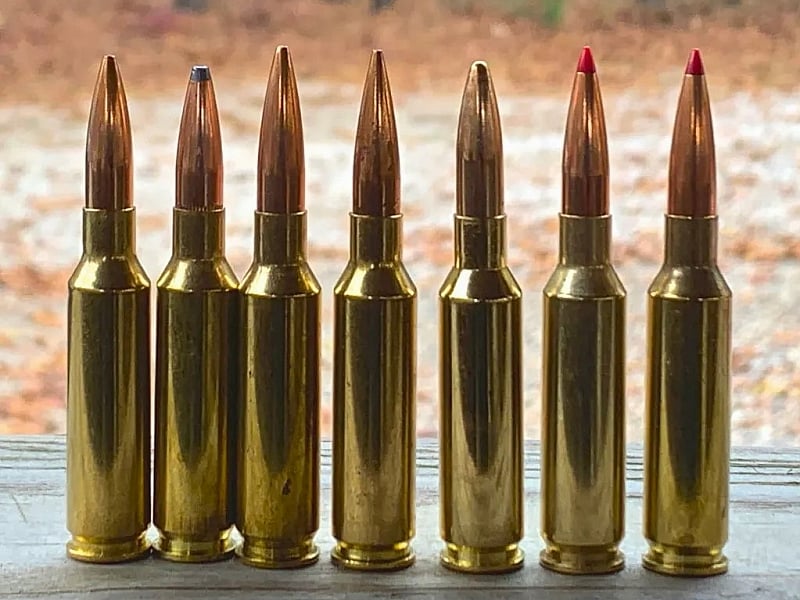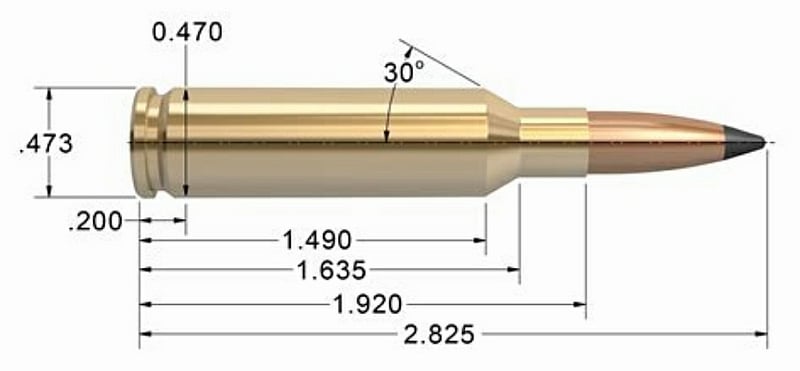The 6.5 Creedmoor is perhaps the hottest centerfire rifle cartridge going right now. Developed by Hornady, the Creedmoor burst on the precision rifle scene in 2007 and has since branched out to the long-range and hunting worlds. What began as one man’s quest for an easily accessed and easily duplicated competition round has blossomed into a nationwide phenomenon.

A Momentous Conversation
Renowned High Power Rifle competitor Dennis DeMille was upset. It was 2005, at the Camp Perry National Matches. DeMille was frustrated by the difficulty of dialing in the reloading data for his current cartridge of choice, the 6XC. DeMille’s company, Creedmoor Sports, was the exclusive distributor of Tubb 2000 competition rifles chambered for 6XC.
The problem was that the 6XC was still essentially a wildcat cartridge, meaning it had to be hand loaded. But the inconsistent load parameters led to equally inconsistent performance. Many of DeMille’s fellow competitors barraged him with questions for which he had few answers. “People were passing around load data by word of mouth,” DeMille recalled, “and things like blown primers and stiff bolt-lifts were common.” DeMille was so unsettled that he considered withdrawing from the competition and going home.
He voiced his frustration to his friend Dave Emary, the senior ballistician at Hornady. Emary convinced DeMille to stay and asked him to list everything he would want if he could design a new High Power competition cartridge. DeMille gave Emary the list a day later. In his mind, the perfect cartridge would:
- Be magazine length to facilitate competitive rapid-fire strings.
- Be a soft shooter. Light recoil aids rapid fire and takes less of a toll on shooters.
- Shoot an accurate, high ballistic coefficient bullet that travels on a flat trajectory.
- Facilitate good barrel life, unlike some other competition cartridges.
- Be easily replicated by using commonly available components, including powder.
- Have the reloading information conveniently printed on the ammo box.
- Be produced in sufficient quantity to meet expected demand.
- Demille wanted to be able to walk into a store, buy his ammo, and go compete.

Hornady Steps Up
Emary went to work. He collaborated with Hornady’s Assistant Director of Engineering, Joe Thielen. Thielen notes that the new cartridge had to be the same length as the .308 Winchester, to match the magazines being used by the High Power competition rifles. Thielen also says that accuracy was more important than velocity. The cartridge had to be accurate across “several recipes of powders and bullets…it had to shoot, and it had to shoot extremely well.”
Hornady began with the .30 T/C case, which was easy to form to 6.5mm. Emary said that “The .30 T/C was still pretty new then and going to a 6.5 was just logical. You absolutely cannot beat the aero ballistic performance of 6.5 bullets if they are done right.” Thielen relates how Hornady played with the new experimental cartridge, dialing in the performance and ballistics, to deliver what DeMille had asked them for.

As noted, accuracy was a primary requirement. That accuracy was partly delivered by mating the slim bullet to a relatively large diameter case with a shorter length. The Creedmoor is a short action cartridge, though on the longer end of that classification. The shorter, fatter case means the powder burns more quickly than a longer-cased cartridge. The quicker burn equates to a more uniform explosion and gas expansion, delivering greater accuracy.
The bullet’s sectional density also contributes. The slim bullet has the necessary weight combined with less surface area for wind and friction to negatively impact. That equates to lower drag and wind susceptibility which, in turn, increases accuracy.
The 6.5 DeMille?
Since DeMille inspired the new cartridge, Hornady proposed calling it the 6.5 DeMille, but that was quickly vetoed. “I don’t want to overstate my role in the development of this cartridge,” DeMille said. “It really was Dave and Joe who did the work.” Instead, DeMille suggested the name “Creedmoor,” after Creedmoor Sports, of which he was the general manager. The name also refers to the historic Creedmoor Range on Long Island, New York, where the first National Shooting Matches took place after the Civil War.
A Star is Born
Hornady unveiled the 6.5 Creedmoor at SHOT Show 2007. It was initially produced in only two loads: the 120-grain A-Max and the 140-grain A-Max. Velocity-wise, the 120-grain load delivered 2,910 fps from a 24-inch barrel, with the 140-grain coming in at 2,710 fps. The bullets’ high ballistic coefficient meant the trajectories were superior to the .308, with far less recoil.

The bullets, including the newer loads, stay supersonic out to 1,200 and even 1,500 yards, providing fantastic accuracy at long range. And holding to DeMille’s initial requirements, the average life of a 6.5 Creedmoor barrel is in the 2,100-2,200-round range. Most shooters will not approach that figure.
Emary calls the Creedmoor a “do-anything cartridge.” “With the 140-grain bullets,” he says, “it has the same trajectory as a .300 Win Mag, but with 40 percent of the recoil.” Emary has since been proven right, as the Creedmoor went on to dominate shooting competitions and become a more-than-viable big game cartridge.
New bullets and loads mean the 6.5 Creedmoor is more than capable of taking deer, antelope, wild hogs, and black bears. A skilled shooter can even handle elk and moose. The 6.5 Creedmoor has also made numerous successful trips to the African plains.
Soaring Popularity
The Creedmoor’s performance and versatility have fueled its meteoric rise. The 6.5 Creedmoor chambering availability in bolt action rifles, as of 2020, was second only to the stalwart .308 Winchester, which has been around for 70-odd years. But despite that number two availability ranking, the 6.5 Creedmoor is the top-selling bolt action rifle chambering, meaning that availability will only grow. More options exist in semi-automatic rifles. Those figures translate to plenty of ammo availability and load options, which is always good.
To hear some tell it, the 6.5 Creedmoor can do anything. Despite being labeled a “do-it-all” cartridge, with some merit, the Creedmoor has its limitations like anything else. “Do-it-all” simply means the cartridge performs well in competition, target shooting, and hunting.

Its limitations mainly come in tackling game like grizzly bears, moose, and elk. Don’t try a grizzly with a Creedmoor but as noted, a skilled shooter can indeed bag moose and elk. Just make certain the angle, load, and range are right. And do not conflate long-range target performance with long-range hunting performance. Ringing the gong at 1,000 yards is great, and the Creedmoor will do that for a good shooter. But it lacks the energy to ethically bring down a moose or elk outside 250-300 yards. You can stretch it out to 450-500 yards for deer. After that, you might get a kill, but bleeding energy will make it less certain, though definitely unethical.
Love It or Hate It?
It seems there are few neutral opinions on the 6.5 Creedmoor unless you just don’t care one way or the other. Some shooters swear by the cartridge, to the point they are almost as annoying as Glock fanboys. Almost. On the other hand, some people seem to despise the Creedmoor, though I suspect some of that is a backlash to the fanboys’ exuberance. I once heard a gun store clerk bemoaning “the 6.5 Creedmoor Bros” and just generally making fun of anyone who would shoot the cartridge.
Personally, I’ve mostly fallen into the “don’t care” category, being one of those who is usually purposely behind the curve. But I have been recently exasperated by the Creedmoor’s popularity. As of this writing, I’ve been waiting 13 months for a Winchester Model 70 Super Grade chambered in .270 Winchester. It’s a reward gun that I’ve wanted for a long time. I was originally told it would take six months.

I spoke to a Winchester factory rep yesterday. He told me to expect to wait another year. I replied that I found it unbelievable that Winchester was that far out on their flagship bolt gun in a common caliber. He told me the only Model 70s they even have scheduled for 2023 are chambered in, you guessed it, 6.5 Creedmoor. I bottled up my profane response. It’s not his fault.
But I can’t deny the Creedmoor’s success and I will probably buy one at some point. I’m not a trend follower, but sometimes things are popular for a reason. I think the 6.5 Creedmoor is one of those. And whether I think so or not, much of the shooting and hunting world is on the bandwagon and the 6.5 Creedmoor isn’t going anywhere. It’s probably about time for me to catch up.


